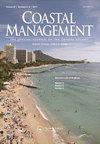Encouraging Living Shorelines over Shoreline Armoring: Insights from Property Owners Choices in the Chesapeake Bay
IF 1.9
4区 环境科学与生态学
Q4 ENVIRONMENTAL SCIENCES
引用次数: 6
Abstract
Abstract This study uses data from shoreline modification permit applications in Gloucester County, Virginia to provide insights into how coastal managers can encourage the use of living shorelines over shoreline armoring. The data show that shorelines are more likely to be modified on properties with high neighboring property values and properties threatened by hurricane storm surge and high wave energy, while modifications are less likely in conservation areas and areas with high percentages of natural cover and agricultural use. Compared to armoring, living shorelines are more likely in FEMA Special Flood Hazard Areas and following recent flooding experiences but are less likely to be installed following an FEMA disaster declaration. Property owners are also significantly more likely to install a specific modification if their neighbors have already installed that modification. Based on these results, coastal managers may be able to increase the effectiveness of interventions to reduce shoreline modification by targeting unmodified high value properties in residential areas with high wave energy. To encourage property owners to install living shorelines over armoring, the results suggest that coastal managers should target properties with armored neighbors or properties in business zones and should develop interventions directly following significant storm events.鼓励生机勃勃的海岸线而不是海岸线装甲:来自切萨皮克湾业主选择的见解
本研究使用了来自弗吉尼亚州格洛斯特县海岸线改造许可申请的数据,以深入了解海岸管理者如何鼓励使用活海岸线而不是海岸线装甲。数据显示,海岸线更有可能被修改的地方是那些周边财产价值高、受到飓风风暴潮和高波能威胁的财产,而在保护区、自然覆盖和农业利用比例高的地区,海岸线修改的可能性较小。与装甲相比,生活海岸线更有可能在联邦应急管理局特别洪水危险区域和最近的洪水经历之后安装,但在联邦应急管理局宣布灾难后安装的可能性较小。如果他们的邻居已经安装了特定的改造,业主也更有可能安装这种改造。基于这些结果,沿海管理者可以通过瞄准具有高波浪能的住宅区中未修改的高价值属性来提高干预措施的有效性,以减少海岸线的改变。为了鼓励业主在装甲上安装生活海岸线,研究结果表明,沿海管理者应该针对有装甲邻居的物业或商业区的物业,并应在重大风暴事件发生后直接制定干预措施。
本文章由计算机程序翻译,如有差异,请以英文原文为准。
求助全文
约1分钟内获得全文
求助全文
来源期刊

Coastal Management
环境科学-环境科学
CiteScore
6.00
自引率
0.00%
发文量
24
审稿时长
>36 weeks
期刊介绍:
Coastal Management is an international peer-reviewed, applied research journal dedicated to exploring the technical, applied ecological, legal, political, social, and policy issues relating to the use of coastal and ocean resources and environments on a global scale. The journal presents timely information on management tools and techniques as well as recent findings from research and analysis that bear directly on management and policy. Findings must be grounded in the current peer reviewed literature and relevant studies. Articles must contain a clear and relevant management component. Preference is given to studies of interest to an international readership, but case studies are accepted if conclusions are derived from acceptable evaluative methods, reference to comparable cases, and related to peer reviewed studies.
 求助内容:
求助内容: 应助结果提醒方式:
应助结果提醒方式:


